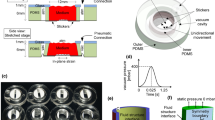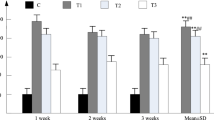Abstract
Recently, human iPS cells derived cardiomyocytes (hiPS-CM) have been utilized as the power source of biological actuators. However, the detailed mechanical properties of hiPS-CM have not been well understood yet. The primary aim of this study was to characterize and compare the stress–strain responses of two-dimensional hiPS-CM sheet and three-dimensional tube structure under self-contractive deformation. Firstly, their pulsation behaviors were examined as the time variation of brightness using a high-speed imaging system. Then, the minimum principal strain values on the surfaces of the sheet and tube were measured using the digital correlation method with the consecutive digital images. The theoretical strain was fund to coincide with the experimental strain vey well, indicating the validity of the developed theoretical models. The stress–strain responses of the sheet and tube were then constructed using the active stress model and the experimental strain. It was found that both the stress–strain responses clearly exhibited viscoelastic behaviors characterized by the hysteresis loop. It was thus concluded that the mechanical responses of hiPS-CM structures could be characterized using the viscoelastic theory along with the active stress model.








Similar content being viewed by others
Data availability
The datasets generated during and/or analyzed during the current study are available from the corresponding author on reasonable request.
Change history
14 December 2022
A Correction to this paper has been published: https://doi.org/10.1007/s42558-022-00049-y
References
Hata, H., Bar, A., Dorfman, S., Vukadinovic, Z., Sawa, Y., Haverich, A., Hilfiker, A.: Engineering a novel three-dimensional contractile myocardial patch with cell sheets and decellularised matrix. Eur. J. Cardiothorac. Surg. 38(4), 450–455 (2010)
Sekine, H., Shimizu, T., Yang, J., Kobayashi, E., and Okano, T., Pulsatile myocardial tubes fabricated with cell sheet engineering, Circulation, 2006, 114, 1_supplement, I-87-I-93.
Tanaka, Y., Sato, K., Shimizu, T., Yamato, M., Okano, T., Kitamori, T.: A micro-spherical heart pump powered by cultured cardiomyocytes. Lab Chip 7(2), 207–212 (2007)
Chikae, S., Kubota, A., Nakamura, H., Oda, A., Yamanaka, A., Akagi, T., Akashi, M.: Three-dimensional bioprinting human cardiac tissue chips of using a painting needle method. Biotechnol. Bioeng. 116(11), 3136–3142 (2019)
Tsuruyama, S., Matsuura, K., Sakaguchi, K., Shimizu, T.: Pulsatile tubular cardiac tissues fabricated by wrapping human iPScells-derived cardiomyocyte sheets. Regenerative Therapy 11, 297–305 (2019)
Kurita, H., Todo, M.: Nonlinear active stress – principal strain relation during pulsation of human iPS cell derived cardiomyocyte sheet. Mech. Mater. 165, 104199 (2022)
Okano, T., Yamada, N., Okuhara, M., Sakai, H., and Sakurai, Y.: Mechanism of cell detachment from temperature-modulated, hydrophilic–hydrophobic polymer surfaces. Biomaterials. 16(4), 297–303 (1995)
Xi, C., Latnie, C., Zhao, X., Tan, J.L., Wall, S.T., Genet, M., Zhong, L., Lee, L.C.: Patient-specific computational analysis of ventricular mechanics in pulmonary arterial hypertension. J. Biomech. Eng. 138(11), 11101 (2016)
Smoluk, A., Smoluk, L., Lisin, R., Protsenko, Y.: Experimental study and modelling the evolution of viscoelastic hysteresis loop at different frequencies in myocardial tissue. Acta Bioeng. Biomech. 19(3), 11–17 (2017)
Guccione, J.M., Waldman, L.K., McCulloch, A.D.: Mechanics of active contraction in cardiac muscle: Part II—cylindrical models of the systolic left ventricle. J. Biomech. Eng. 115(1), 82–90 (1993).
Guccione, J.M., McCulloch, A.D., Waldman, L.K.: Passive material properties of intact ventricular myocardium determined from a cylindrical model. J. Biomech. Eng. 113(1), 42–55 (1991)
Guccione, J.M., McCulloch, A.D.: Mechanics of active contraction in cardiac muscle: part I - constitutive relations for fiber stress that describe deactivation. J. Biomech. Eng. 115(1), 72–81 (1993)
Walker, J.C., Ratcliffe, M.B., Zhang, P., Wallace, A.W., Fata, B., Hsu, E.W., Saloner, D., Guccione, J.M.: MRI-based finite-element analysis of left ventricular aneurysm : American Journal of Physiology-Heart and Circulatory. Physiology 289(2), H692–H700 (2005)
Funk, J.R., Hall, G.W., Crandall, J.R., Pilkey, W.D.: Linear and quasi-linear viscoelastic characterization of ankle ligaments. J. Biomech. Eng. 122, 15–22 (2000)
Whitecomb, K.: Determining the linear viscoelastic region in oscillatory measurements, Application Note, TA Instruments, RH107.
Rassier, E.D.: Sarcomere mechanics in striated muscles: from molecules to sarcomeres to cells. Am. J. Physiol. Cell Physiol. 313(2), C134–C145 (2017)
Funding
This research was supported by JSPS Grants-in-Aid for Scientific Research(B) (No.18H01338 and 21H01215).
Author information
Authors and Affiliations
Corresponding author
Ethics declarations
Conflict of interest
The authors declare no competing interests.
Additional information
Publisher's note
Springer Nature remains neutral with regard to jurisdictional claims in published maps and institutional affiliations.
Rights and permissions
Springer Nature or its licensor (e.g. a society or other partner) holds exclusive rights to this article under a publishing agreement with the author(s) or other rightsholder(s); author self-archiving of the accepted manuscript version of this article is solely governed by the terms of such publishing agreement and applicable law.
About this article
Cite this article
Todo, M., Kurita, H. Comparison of stress–strain response of iPS cell-derived cardiomyocytes sheet and tube structures. Mech Soft Mater 4, 10 (2022). https://doi.org/10.1007/s42558-022-00048-z
Received:
Accepted:
Published:
DOI: https://doi.org/10.1007/s42558-022-00048-z




